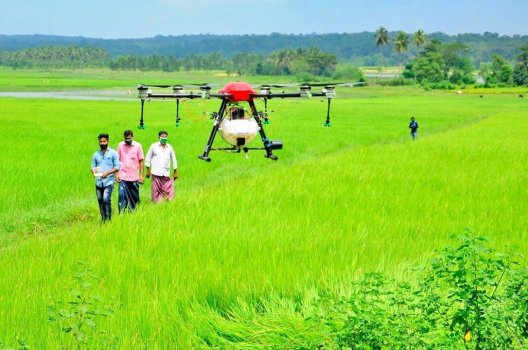K
Kathleen Martin
Guest
The much-anticipated PM Kisan Samman Sammelan held in October brought together over 13,500 farmers, 1,500 agri start-ups, other stakeholders.
At the conference, Prime Minister Narendra Modi highlighted initiatives like Kisan Rail, DBT transfers, Soil Health Cards, e-NAM, and neem coating of urea, that have adopted, integrated and scale-up technology in agriculture. Another such revolutionary technology to add to farmers’ prosperity and dignity, is drones.
World Economic Forum (WEF) in its latest report stated that drones have the potential to be the harbinger of “technology-led transformation” of Indian agriculture.
In India’s $600 billion agriculture sector, they are currently used for pesticide and nutrient application, mapping water spread area, sampling water, mapping macrophyte infestation etc. As per WEF, drone usage could reduce cost of application by 20 per cent and also mitigate health hazards of manual work, thereby promoting precision agriculture.
Drones enable data collection and resource efficient nutrient application. This data facilitates crop production forecast, and evidence-based planning. The government can announce relief packages for farmers in time, leading to better sowing, irrigation and harvesting cycles. With drones, government initiatives like Per Drop More Crop will improve and water use inefficiency in irrigation will decline.
Streamlining schemes
Second, drones’ data integrated with GIS and Google Earth satellite images will eventually streamline schemes like PMFBY by aiding crop cutting experiments, crop-loss estimation, insurance determination and dispute resolution.
Third, with drones, agri-research will become “highly customised and localised”. Finally, drones can capture backward and forward linkages. With objective and standardised data on crop quality, food processing industries will procure from farmers at better prices. Agri-exports will also increase with technology-supporting compliance with global standards.
The need is to scale up drone use in agriculture sector from the present 10,000 aerial vehicles. Civil military engagement should be promoted to realise gains from cross-industry application of drones.
Consultations may be held with experienced strategic partners like Israel where AI-enabled drones are used for mapping plots, assessing crop damage, and even plucking only ripe apples.
Continue reading: https://www.thehindubusinessline.com/opinion/drones-giving-farmers-the-wings-to-fly/article66074624.ece
At the conference, Prime Minister Narendra Modi highlighted initiatives like Kisan Rail, DBT transfers, Soil Health Cards, e-NAM, and neem coating of urea, that have adopted, integrated and scale-up technology in agriculture. Another such revolutionary technology to add to farmers’ prosperity and dignity, is drones.
World Economic Forum (WEF) in its latest report stated that drones have the potential to be the harbinger of “technology-led transformation” of Indian agriculture.
In India’s $600 billion agriculture sector, they are currently used for pesticide and nutrient application, mapping water spread area, sampling water, mapping macrophyte infestation etc. As per WEF, drone usage could reduce cost of application by 20 per cent and also mitigate health hazards of manual work, thereby promoting precision agriculture.
Drones enable data collection and resource efficient nutrient application. This data facilitates crop production forecast, and evidence-based planning. The government can announce relief packages for farmers in time, leading to better sowing, irrigation and harvesting cycles. With drones, government initiatives like Per Drop More Crop will improve and water use inefficiency in irrigation will decline.
Streamlining schemes
Second, drones’ data integrated with GIS and Google Earth satellite images will eventually streamline schemes like PMFBY by aiding crop cutting experiments, crop-loss estimation, insurance determination and dispute resolution.
Third, with drones, agri-research will become “highly customised and localised”. Finally, drones can capture backward and forward linkages. With objective and standardised data on crop quality, food processing industries will procure from farmers at better prices. Agri-exports will also increase with technology-supporting compliance with global standards.
The need is to scale up drone use in agriculture sector from the present 10,000 aerial vehicles. Civil military engagement should be promoted to realise gains from cross-industry application of drones.
Consultations may be held with experienced strategic partners like Israel where AI-enabled drones are used for mapping plots, assessing crop damage, and even plucking only ripe apples.
Continue reading: https://www.thehindubusinessline.com/opinion/drones-giving-farmers-the-wings-to-fly/article66074624.ece

